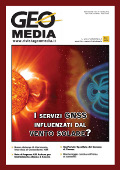Attività solare, effetti ionosferici e servizi NRTK: quali connessioni?
Parole chiave:
Attività solare, ionosfera, Total Electron Content (TEC), GNSSAbstract
Come noto anche dalle più recenti cronache dei quotidiani l'attività solare si trova in un periodo di rapida crescita, all'interno di un ciclo periodico della durata di 11 anni. Questo si traduce nella presenza di macchie solari (Sunspot), eruzioni solari ed emissione di massa coronarica che producono campi magnetici che dalla superficie, attraverso il cosiddetto vento solare, arrivano ad alterare l'equilibrio del campo magnetico terrestre. Lo strato più periferico dell'atmosfera terrestre, la ionosfera, è il primo a subire gli effetti prodotti dall'attività solare in quanto gli ioni e le molecole ionizzate che esso continente tendono ad aumentare come numero in seguito all'attività ionizzante prodotta dal "vento solare”. La ionizzazione dello strato ionosferico, a sua volta, incide sulla propagazione dei segnali GNSS, essendo la ionosfera un mezzo dispersivo (che influenza in modo selettivo i segnali in funzione delle loro caratteristiche). Questo studio cerca di verificare quali possono essere gli effetti dell'attività solare sulle prestazioni dei servizi NRTK (Network Real Time Kinematic) attraverso l'analisi delle prestazioni raggiunte dagli utenti di un servizio di posizionamento nell'anno 2011, periodo caratterizzato da una rapida ascesa dell'attività solare verso i massimi previsti per il primo semestre del 2013.
As recognized by hundreds of years of sun observation by the researcher in eliophysics, the Sun is now entering in a period of increased activity. The producing of sunspots, solar flares and coronal mass ejection from the Sun's surface is able to create anomalies in the magnetic field that could stream towards the Earth. The terrestrial magnetic field may be influenced by the "solar wind” and the ionized upper layer of the atmosphere, called ionosphere, could be affected by scintillation and induced delays of the travelling signals. Several critical infrastructures would be influenced by such a disturbance. The 11-years long cycle of solar activity is expected to reach the peak by the middle of the year 2013 and possible effects on the GNSS (Global Navigation Satellite System) services have to be accounted for. This is because of the properties by the ionospheric layers to delay the GNSS signals depending on the electron density within the ionospheric strata. This study focuses on the effects of the ionospheric disturbance on the NRTK (Network Real Time Kinematic) services through the analysis of the performances achieved by the users during the year 2011, when a fast rising in ionospheric activity was recorded by the end of the year. A relationship between the reliability of positioning and the ionospheric activity was found.
Riferimenti bibliografici
Biagi L. (2009), I fondamentali del GPS. Geomatics Workbooks, vol. 8.
Cina A, Manzino A, Piras M. (2008), Le reti NRTK alla luce del nuovo formato RTCM3. Bollettino SIFET 2, 81-105.
Hathaway DH, Wilson RM, Reichmann EJ. (1994), The Shape of the Sunspot Cycle. Solar Physics, 151, 177-190.
Petrosillo M, Dabove P, De Agostino M. (2011), What effects does network size have on NRTK positioning? Inside GNSS, vol. 6, n. 6, 24-29.
Pubblicato
Come citare
Fascicolo
Sezione
Licenza
Gli autori che pubblicano su questa rivista accettano le seguenti condizioni:- Gli autori mantengono i diritti sulla loro opera e cedono alla rivista il diritto di prima pubblicazione dell'opera, contemporaneamente licenziata sotto una Licenza Creative Commons - Attribuzione che permette ad altri di condividere l'opera indicando la paternità intellettuale e la prima pubblicazione su questa rivista.
- Gli autori possono aderire ad altri accordi di licenza non esclusiva per la distribuzione della versione dell'opera pubblicata (es. depositarla in un archivio istituzionale o pubblicarla in una monografia), a patto di indicare che la prima pubblicazione è avvenuta su questa rivista.
- Gli autori possono diffondere la loro opera online (es. in repository istituzionali o nel loro sito web) prima e durante il processo di submission, poiché può portare a scambi produttivi e aumentare le citazioni dell'opera pubblicata (Vedi The Effect of Open Access).





